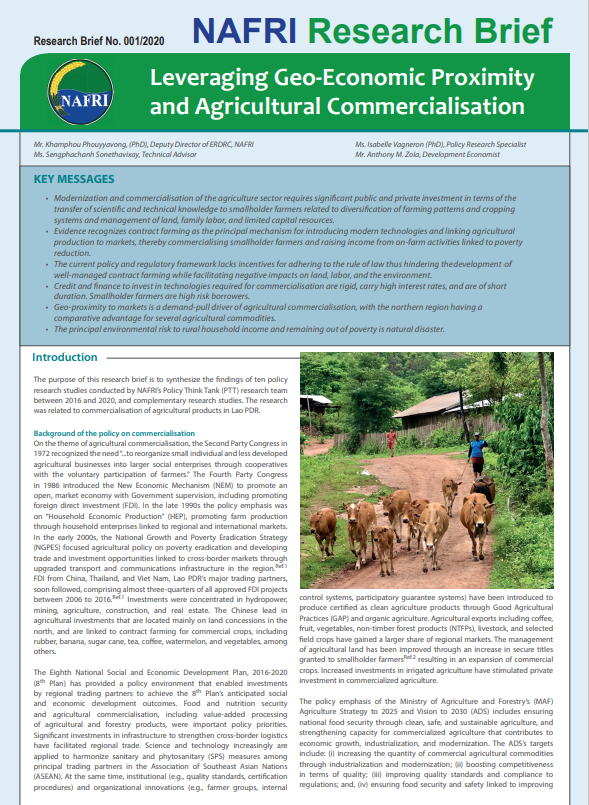
Background of the policy on commercialisation
On the theme of agricultural commercialisation, the Second Party Congress in 1972 recognized the need “ ...to reorganize small individual and less developed agricultural businesses into larger social enterprises through cooperatives with the voluntary participation of farmers.” The Fourth Party Congress in 1986 introduced the New Economic Mechanism (NEM) to promote an open, market economy with Government supervision, including promoting foreign direct investment (FDI). In the late 1990s the policy emphasis was on “Household Economic Production” (HEP), promoting farm production
through household enterprises linked to regional and international markets. In the early 2000s, the National Growth and Poverty Eradication Strategy (NGPES) focused agricultural policy on poverty eradication and developing trade and investment opportunities linked to cross-border markets through upgraded transport and communications infrastructure in the region.Ref.1
FDI from China, Thailand, and Viet Nam, Lao PDR’s major trading partners, soon followed, comprising almost three-quarters of all approved FDI projects between 2006 to 2016.Ref.1 Investments were concentrated in hydropower, mining, agriculture, construction, and real estate. The Chinese lead in agricultural investments that are located mainly on land concessions in the north, and are linked to contract farming for commercial crops, including rubber, banana, sugar cane, tea, coffee, watermelon, and vegetables, among others.
The Eighth National Social and Economic Development Plan, 2016-2020 (8th Plan) has provided a policy environment that enabled investments by regional trading partners to achieve the 8th Plan’s anticipated social and economic development outcomes. Food and nutrition security and agricultural commercialisation, including value-added processing of agricultural and forestry products, were important policy priorities. Signif cant investments in infrastructure to strengthen cross-border logistics have facilitated regional trade. Science and technology increasingly are applied to harmonize sanitary and phytosanitary (SPS) measures among principal trading partners in the Association of Southeast Asian Nations
(ASEAN). At the same time, institutional (e.g., quality standards, certification procedures) and organizational innovations (e.g., farmer groups, internal control systems, participatory guarantee systems) have been introduced to produce certified as clean agriculture products through Good Agricultural Practices (GAP) and organic agriculture. Agricultural exports including coffee, fruit, vegetables, non-timber forest products (NTFPs), livestock, and selected field crops have gained a larger share of regional markets. The management of agricultural land has been improved through an increase in secure titles granted to smallholder farmersRef.2 resulting in an expansion of commercial crops. Increased investments in irrigated agriculture have stimulated private investment in commercialized agriculture.
The policy emphasis of the Ministry of Agriculture and Forestry’s (MAF) Agriculture Strategy to 2025 and Vision to 2030 (ADS) includes ensuring national food security through clean, safe, and sustainable agriculture, and strengthening capacity for commercialized agriculture that contributes to economic growth, industrialization, and modernization. The ADS’s targets include: (i) increasing the quantity of commercial agricultural commodities through industrialization and modernization; (ii) boosting competitiveness in terms of quality; (iii) improving quality standards and compliance to regulations; and, (iv) ensuring food security and safety linked to improving nutrition. Most recently (February 2020), the Lao People’s Revolutionary Party’s Politburo told leaders of central and provincial Party committees to improve policy implementation of providing credit for rural development and poverty reduction aimed at minimizing income inequality. Important measures include: promoting agricultural enterprises; protecting land use rights; providing extension services to encourage modern collective farming linked to markets; encouraging local and foreign private investment; appropriate arrangements for contract farming including the ‘2+3’ and ‘1+4’ models; operating agriculture and forestry demonstration centers to increase investments in and application of scientifc research; and, improving market access roads linking production supply chains to local and regional markets. In this context, the 9th Plan is expected to emphasize the geo-economic proximity of Lao PDR, to maximize locational advantages within ASEAN. Soft connectivity – more intensive economic interactions through preferential trade and investment agreements – and hard connectivity – in the form of upgraded roads, railways, ports, and airlinks to enable information and communications technology (ICT) – are prospective priorities.
National Agriculture and Forestry Research Insitute (NAFRI), Ministry of Agriculture and Forestry (MAF)